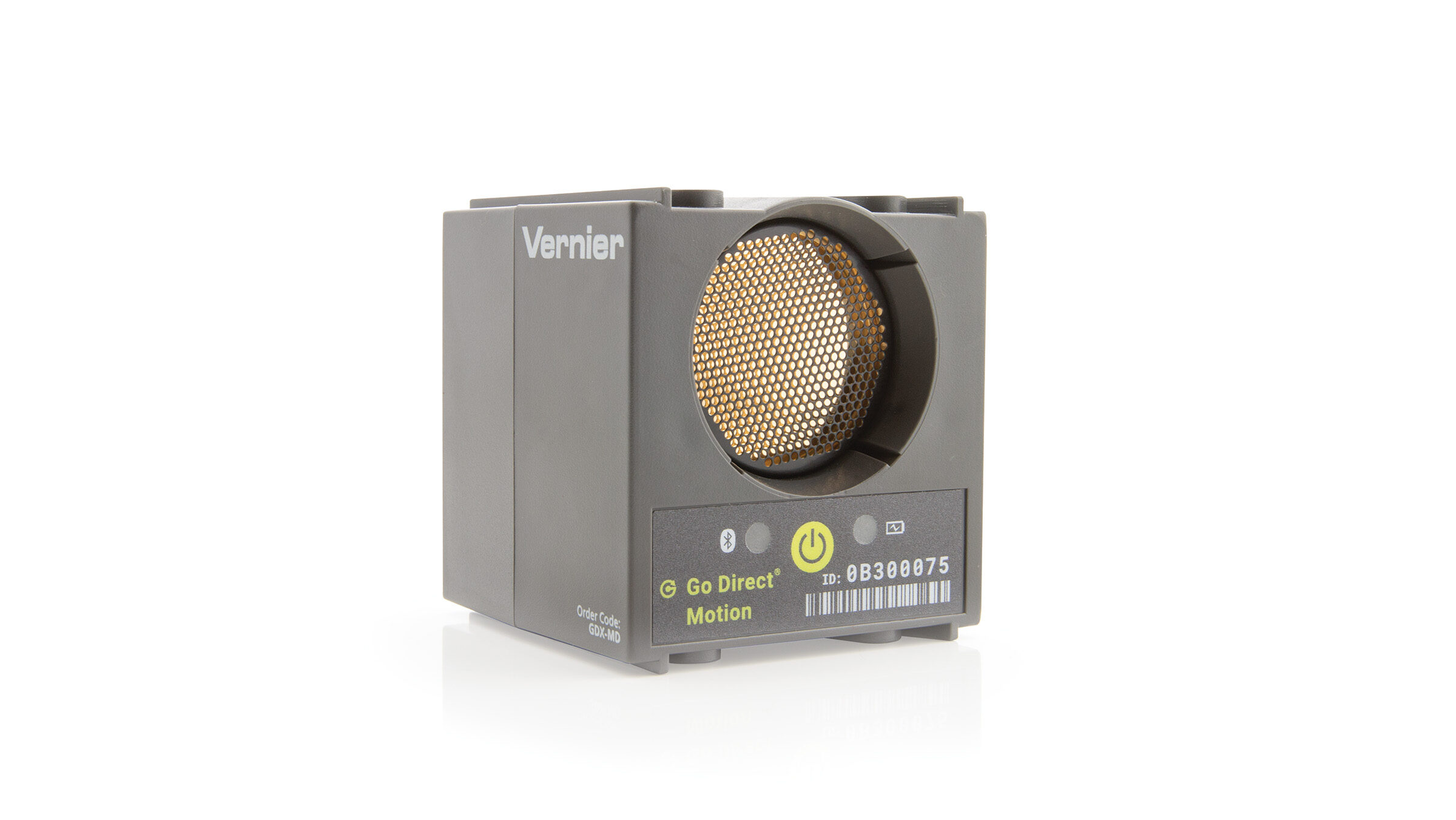Go Direct® Motion Detector (GDX-MD )

Troubleshooting
Press the power button on the sensor to turn it on. Connect your sensor as described in the Getting Started instructions for your device.
- Primary test: Do you hear a clicking from the motion detector when connected to the data collection app? If not, the sensor may be defective.
- Secondary test: If the Motion Detector is not working when connected via USB, the cable could be malfunctioning. Try a cable from a sensor.
- Tertiary test: To test accuracy, find a wall with no desks, chairs, doors, or other obstructions within a 2 m field. Hold the Motion Detector in your hand, 0.5 m from the wall with the gold disc pointing directly at the wall. Do you get the expected 0.5 m reading? Back off to 1.0 m. Do you get 1.0 m? Back farther off to 1.5 m. Do you get 1.5 m?
- Quaternary test: Motion Detectors use ultrasound to measure position. Other sources of ultrasound may be interfering with the signal. Those sources include air tracks, CRT computer monitors, fluorescent lights, and power distribution panels. Identifying these sources can be challenging. You may have to resort to moving the Motion Detector away from interfering equipment. In the case of noisy fluorescent lights, turn them off (but we rarely see this problem).
Usage Tips
- Tip 1: The optimum collection rate is 20 samples/second. The maximum sample rate that you can use for this motion detector is 30 samples/second.
- Tip 2: Clear all objects within the 30º cone.
- Tip 3: If you are monitoring the motion of objects on a table or track, use the Motion (cart) sensor channel. (See How can change the sensor channels used with data collection for Go Direct sensors having multiple sensor channels?)
- Tip 4: Increase the target’s area (e.g., tape an index card to the object such that the ultrasound will detect the flat surface of the card).
- Tip 5: Noisy velocity data: increase the number of points used for derivative calculations. See How do I adjust the number of points used in derivative calculations?
Additional Troubleshooting
- Why am I getting Motion Detector readings that are noisy or max out at a certain distance?
- Go Direct Sensor always reads zero (or some other constant value).
- Why don't I get a freefall acceleration value of 9.8 m/s2 when using a Motion Detector?
- How does a Vernier Motion Detector work (electrically)?
- Should I use a photogate or a Motion Detector?
- How do I improve the results from a Motion Detector with an air track?
- Will your Motion Detector show the speed of a (car, baseball, racquetball)?
- How do I attach the Motion Detector bracket to the Vernier track?
- Which motion detector should I buy? What are the differences between them?
- Which Motion Detector model do I have?
- Go Direct sensor does not connect to LabQuest 2 via Bluetooth.
- How do I remove or replace a Go Direct battery?
- Troubleshooting Bluetooth Connections with Go Direct Sensors
- What can I do if a Go Direct sensor's Bluetooth LED flashes red and green when I try to connect to it and the connection fails?
- Will my device work with Go Direct Sensors via Bluetooth?
- How do I know if my LabQuest will work with Go Direct Sensors and Go Wireless devices?
Specifications
- Range
⚬ Motion and Motion with TC sensor channels: 0.25 m to 3.5 m
⚬ Motion (cart) sensor channel: 0.15 m to 3.5 m - Resolution: 1 mm
- Accuracy: 2 mm
- Temperature Compensation
⚬ Motion with TC sensor channel only
⚬ Internal temperature sensor responds to dynamic temperature changes - Maximum sampling rate: 30 samples/s
- Sensor dimensions:
⚬ Length: 6.5 cm
⚬ Width: 6.4 cm
⚬ Height: 6.8 cm - Ultrasound frequency: 50 kHz
- Power consumption: 51 mA
- Connections:
⚬ Wireless: Bluetooth® v4.2 (wireless range 30 m unobstructed)
⚬ Wired: USB 2.0 full speed - Battery: 650 mAh Li-Poly
⚬ Battery Life (single, full charge): ~24 hours continuous data collection
⚬ Battery Life (lifetime): 2 – 5 years (typical)
Calibration
The default Motion sensor channel and the Motion (cart) sensor channel are factory calibrated and generally don’t require calibration. For better accuracy, you can calibrate these sensor channels by placing the front surface of the sensor a known (measured) distance from a flat object/surface such as a book, box, or wall and performing a one-point calibration. For more information, see Is there a way to calibrate a Motion Detector?.
The Motion with TC sensor channel uses an internal temperature sensor to determine the speed of sound to be used in calculations. This sensor channel cannot be calibrated.
Battery Troubleshooting
- If the sensor can be turned on when connected by USB but not when disconnected from USB, the battery likely needs charging.
⚬ Charge the sensor for several hours and try again. - If the sensor shows fully charged but still won’t turn on when connected via USB, then the battery has likely disconnected.
⚬ Check the battery connection. - If the sensor still won’t turn on, try swapping the battery with a working sensor to see if the problem follows the battery or stays with the sensor.
⚬ If the problem stays with the sensor, the battery is probably not the issue.
⚬ If the problem follows the battery, the battery has likely reached its end of life. - If the battery is indeed at the end of its life, the sensor cannot be used even if connected by USB, so the battery will need to be replaced. Go Direct® 650 mAh Replacement Battery (
GDX-BAT-650 ) - See How do I remove or replace a Go Direct battery? for more information (including a video).
Rechargeable batteries are covered by a one-year warranty.
Batteries should last two to five years in typical use.
Related Products
- Micro USB to USB-C Cable (
CB-USB-C-MICRO ) - Go Direct® Charge Station (
GDX-CRG ) - Motion Detector Clamp (
MD-CLAMP ) - Motion Detector Bracket (
DTS-MDB ) - Motion Detector (
MD-BTD ) - CBR 2 (
CBR2 ) - Go! Motion (
GO-MOT )
Replacement Parts
- Go Direct® 650 mAh Replacement Battery (
GDX-BAT-650 ) - Micro USB Cable (
CB-USB-MICRO )
